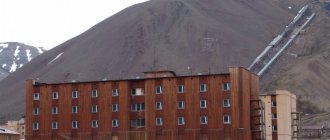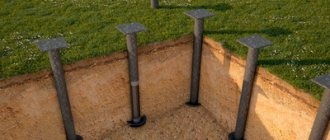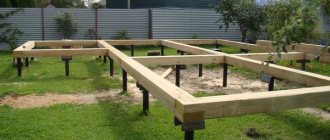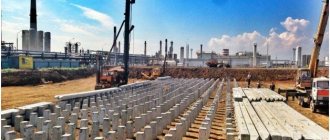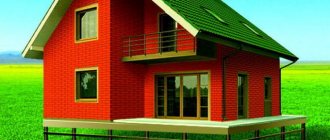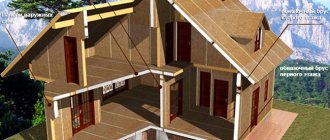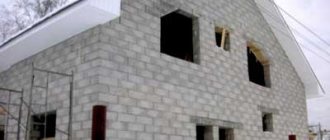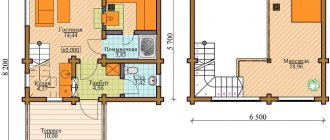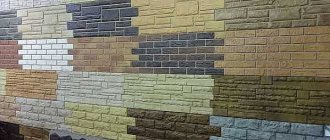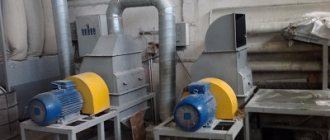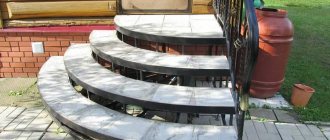When building a house, great importance is given to the construction of the foundation. We have said more than once that the foundation is the foundation of the future home. That's why it needs to be taken seriously. The soil and soil quality of the area where the house will be built is of key importance when choosing the type of foundation. Today we will look at the pros and cons of a pile foundation. The entire construction technology depends on the type of soil on the site, so before starting to build a house, we recommend that you definitely do geotechnical surveys. This will allow you to accurately determine the type of foundation for building your home.
In many regions of Russia, swampy, flooded or weak-bearing soils predominate. This makes the construction process problematic. This is especially true for the construction of private houses. But nevertheless, it is necessary to build somehow, and the use of a traditional strip or even slab foundation on such soils is simply unacceptable. In such cases, a pile foundation comes to the rescue. It is based on the installation of supporting structures. Such structures ensure good contact of the future house with dense layers of soil. And most importantly, they allow you to build very large and massive structures without fear for their stability. But is such a foundation good and safe? Are there any disadvantages of a pile foundation and what are they? Let's sort it out in order.
An example of a pile foundation for a house
Next, we will examine in detail the lighter version of the pile foundation. This includes screw piles. We'll tell you how to install screw piles so that they don't fail. And also what are the advantages of screw piles for the foundation of a house.
Foundation on screw piles
What are screw piles? What are their features and convenience? And how to make a foundation with their help? Screw piles are such a support structure. It is a system of pipes that are immersed in the ground to a certain depth. Spiral blades are welded at the bottom of these pipes (as in the photo). This design allows you to screw piles into the ground. And the blades play the role of cutting, with approximately the same effect as on screws. The sharp tip of the pile makes it easier for it to penetrate the ground. And the thread, in addition to being used for screwing, is also a support unit on which the pile actually rests.
How is the support supported and how reliable is it, you ask? We answer: such a pile is supported by the friction force that occurs between the soil and the side surfaces of the pile (pipe). This design is reinforced by the same blades that we have already talked about. They bear part of the load, which makes such a support very reliable, with proper installation, of course. By the way, the installation of such piles itself has a lot of subtleties that must be observed. Failure to comply with them may result in the pile being flimsy and unreliable. So, in order to evenly distribute the load on each pile, the installation is carried out according to a pre-calculated scheme. A so-called pile field is formed. It ensures an even load on each support.
Grillage
When the piles are already immersed, their upper parts are cut off in such a way that a flat plane is obtained. Then they make a grillage or otherwise call it a load-bearing belt. This is the main structure that distributes the load from the walls. And most importantly, thanks to it, the load on the pile system is distributed evenly, without overloading any of the piles, which gives this structure reliability and durability.
The structure and functions of the grillage are very similar to the design of a strip foundation. The difference in this design is that the grillage, instead of being supported on the ground, like a strip foundation, is supported on piles. In order for the structure to become rigid and less susceptible to lateral loads, the hollow tubes of the piles are filled with concrete after installation. This creates additional stability and rigidity of the structure.
Of course, there are both pros and cons of a pile foundation. But the clear advantage of screw piles is that when installing them, it is not necessary to immerse them until they come into contact with dense layers of soil, as with other piles. The peculiarity of their design allows them to reliably hold the building with sufficient penetration into the ground. Screw piles are a hanging type of piles.
Grillage arrangement
Construction of a pile-grillage foundation.
First, holes are drilled around the entire perimeter, into which roofing felt is inserted for casing. Then the associated reinforcement is inserted, which should protrude from the pit to connect to the grillage. The pits are filled with concrete and waited 7 days to reach the required strength.
Grillage reinforcement.
First of all, the formwork is assembled, on the bottom of which sand or insulation is laid. Waterproofing on the pillars must be placed on top, after which the reinforcement cap is tied in and connected to the pile reinforcement. When everything is ready, you can pour concrete. After the grillage has become stronger, you can remove the previously poured sand from under it, thus creating a gap. It is not recommended that the grillage between the posts lie on the ground.
For which buildings is a pile-grillage foundation designed?
Most often, prefabricated reinforced concrete grillages are used in country house construction for small, lightweight houses made of:
- glued timber;
- rounded logs;
- light brick;
- expanded clay blocks, foam blocks;
- sandwich panels;
- frame-panel.
What kind of soil is it recommended to use such a foundation?
A pile-grillage foundation is perfect for heaving soil with high groundwater, on the banks of rivers, lakes, and on almost any soil except rocky ones. To build on uncertain terrain, it would be good to inspect houses that have been built a long time ago and do not have skewed piles. We need to take an example from such buildings for more confident construction. If this is not possible, then it is better to contact specialists.
Pros and cons of pile foundations and screw piles
Below we will try to highlight the obvious advantages of screw piles. Of course, any choice in favor of one or another method of installing a foundation depends more on the conditions that exist specifically on your site. But we decided to highlight the general advantages that will help you make a choice based on your individual conditions. And so, the advantages of screw piles include:
- Fast installation.
- Screw piles can be installed manually. This fact makes it possible to build such a foundation next to ready-made buildings.
- Price. Screw piles cost much less than other types of foundations.
- Screw piles can be reused. If the need arises, such piles can be removed and reused elsewhere.
- The big advantage is that installation of screw piles does not require excavation work.
- Screw piles allow construction in areas where there are slopes or folds in the terrain.
- Another important advantage is that during installation you do not need to use complex equipment, which makes the installation process easier and cheaper.
The advantages of screw piles
The disadvantages of a pile foundation and screw piles in particular are given below. The disadvantages are associated not with the structure itself, but with the conditions in which it is unacceptable to use this type of foundation. Here's what it includes:
- Corrosion may appear on the piles, as operating conditions contribute to this.
- In regions where there is high seismic activity, the use of screw piles is prohibited.
- Do not immerse in rocky soil.
- If you plan to install screw piles on loose and weak-bearing soils that do not provide acceptable lateral support for the piles, then additional study is required to determine the sufficient immersion depth of the screw piles.
Often, as it happens, many of the shortcomings of screw piles are deliberately hushed up by manufacturers. In this regard, when choosing a pile type of foundation, you need to understand the design features yourself or have a trusted person who understands this. And most importantly, have an idea of the properties of such piles. To choose the most suitable and high-quality option for screw piles.
Screw pile design
Minuses
The disadvantages of pile foundations are:
- To carry out the work, high-quality geological exploration of the site and detailed soil analysis are required. Test drilling is carried out to the entire expected depth of the piles. All work must be carried out by trained and experienced people, which often becomes a serious problem.
- Driving piles requires construction equipment, which is not always possible to approach the site. The larger the size of the pile field and the length of the shafts, the more difficult it is to organize and coordinate the availability of the necessary mechanisms and the people who operate them.
- There is no possibility of creating a normal basement. The maximum you can count on is a small technical underground where some communications may be located.
Despite the presence of negative aspects, pile foundations allow construction in problem areas, which is why they are widespread in Russia and other countries.
What are the types of screw piles?
Screw piles come in various types. They are used depending on soil conditions and other parameters that we will consider. So what are the types of screw supports that are used in the world of modern construction? For convenience, we will divide all types of screw piles into categories.
By area of application in construction
For those who know little about the construction craft, it seems that this type of foundation is used very rarely. But that's not true. This type is used much more widely.
Below we list the areas in which pile structures, screw piles in particular, are widely used:
- Capital construction.
- Individual construction for housing.
- Construction of greenhouses.
- Construction of hangars.
- Fences or enclosures, etc.
- Bridges, piers and other hydraulic structures.
- Load-bearing supports of power lines, masts, etc.
Over the past few decades, the popularity of this type of base has increased significantly. This means that the scope of application of screw piles is only growing and this process is not over yet.
Screw piles design
What are the sizes of piles?
In the manufacture of screw piles, steel pipes of different diameters . Depending on the application, different pile sizes are used. The larger the scale of construction, the thicker the piles should be, this is understandable. But the most common are pipes with a diameter of 108 mm. This size optimally combines fairly good penetration into the ground and high load-bearing capacity.
The diameter range of pile pipes ranges from 57-219 mm. Of course, in some cases, pipes with a larger diameter can be used.
Since the topic of this article is devoted specifically to private housing construction, we will make an amendment that pipes over 159 mm are usually not used. Since with such a thickness there are already certain difficulties in driving piles.
The length of the piles is also key and has several options. Standard sizes range from 1650 mm to 9000 mm. The length of the piles is selected depending on the conditions in which the building must be erected. It is important to understand that the more complex the soil area, the longer the length should be chosen when using piles.
How many blades should there be?
Piles come in various designs. Designs come with one blade or with several blades. Single-blade piles are usually used only on relatively stable soils. Piles with several blades are more suitable for complex and low-bearing soils.
It is important to know. In order not to lose traction with the ground when installing piles, you cannot reverse (reverse movement when screwing in). And also the load on the pile should not be exceeded.
Of course, when constructing important buildings, especially if the soil is weak-bearing, then it is necessary to use multi-bladed piles. Since their design provides greater stability and can withstand higher loads. This is a definite plus in favor of choosing multi-bladed screw piles.
Types of piles
For critical buildings on weak-bearing soils, multi-bladed piles are used, which demonstrate greater resistance to possible loads. Also, an additional argument in favor of choosing just such piles can be the fact that with an increase in the number of blades on the pile, it becomes possible to reduce the diameter of the trunk. And this makes it much easier to dive into the ground.
But it is imperative to ensure that the wall thickness provides the required structural rigidity.
Types of screw pile tips
The main function of the tips is to take on the load when the pile is driven. Therefore, this creates high demands on this structural element. Let's take a closer look at what types of tips there are for screw piles and in which cases which tip is best to use.
Types of screw piles
There are the following types of screw pile tips:
- The first type of tips is welded screw pile tips . They are made by narrowing the thickness of the pipe. Wedge-shaped sections of the pipe are cut out, and then the remaining parts are connected in such a way that a cone is obtained. Next, the seams are welded into a single structure. In this way, a pointed end is achieved. But it is worth noting that this type is only suitable for relatively weak soils. Otherwise, possible obstacles and inclusions of hard areas will simply destroy such a tip.
- The second type of tips, which is distinguished by its reliability and durability, is the cast tips of screw piles. They are made by casting from durable steel, and then additionally attached to the pipe. Such tips are massive, have greater thickness and have the ability to destroy inclusions that occur when installed in the ground. These tips are perfect for difficult soils that have a high density.
Screw pile options
What material are screw piles made of?
The material used for making screw piles is, of course, steel, but the grade of steel may vary depending on the level of construction. Of course, the material directly affects the cost of the pile, so the higher the steel grade, the higher the cost. Usually they use steel from the usual St3 to the more durable St20. If it is necessary to build in highly aggressive soils, where the loads are high and there is the possibility of electrostatic corrosion of the material, fairly durable steel grades 30 KhMA and 09G2S can be used. Below is a table of properties for different grades of steel.
Properties table for various steel grades
Type of protective coating for screw piles
The protective layer that covers ready-made piles is of great importance. Zinc is most often used for these purposes. It is applied in layers to the piles. But the material itself must be very resistant to corrosion. This combination provides good protection, and this in turn increases the service life and reliability of the structure.
The polymer materials that are used for the coating are erased while screwing the piles into the ground, which means they do not fulfill their task. Such a coating is necessary only to protect the outer part of the pile. In addition, this coating requires regular updating.
With the advancement of construction technology, many engineers are proposing innovative methods for protecting piles. They offer different methods from mastics to a rubber layer. But such methods have not yet become widespread and popular among builders.
How piles are driven: machines and installation technology
If it is necessary to build structures on problematic soils, a pile foundation is the most rational option among other types of foundations.
For example, on swampy, moving or loose soil, with a high level of groundwater. Piles are widely used in individual as well as industrial construction. And if for an individual one-story building you can do without the use of special mechanisms, then in industrial quantities it is simply necessary to use special devices and machines. Let's see how piles are driven when creating the foundation of a large object.
Optimal screw piles for the construction of a private house
Of course, you must understand that without a preliminary analysis of the soil and the state of the area, it is simply not possible to say that some piles are suitable and others are not. You also need to take into account the weight of the future house, and for this you need to calculate it at the beginning (in this article there are calculation formulas for a slab foundation, but the weight of the house does not change depending on the type of foundation). The table will help you.
Weight calculation
If we proceed from the specifics of the construction, which involves the creation of a relatively light house with a small number of floors, then the most appropriate option would be to use single-bladed trunks with a diameter of 57 to 108 mm, depending on the type and condition of the soil .
Let's take the following data as an example. We are planning to build a relatively light house with a small number of floors. Based on these conditions, the most suitable option would be to use single-blade piles with a diameter of 57 mm to 108 mm. Why is there such a big difference, you ask? Everything is very simple, the choice of diameter will depend on the condition and type of soil on which you plan to build the house. Of course, as we said earlier, in order to get more information and not make a mistake with the diameter and type of screw piles, it is necessary to conduct a survey of the site and a detailed study of the soil.
Another important indicator is the load that will put pressure on the pile. For example, let's say that with a diameter of 57 mm, a pile can withstand a load of approximately 800 kg . So it turns out that naming the pros and cons of a pile foundation and screw piles is not so simple. To do this, you need to know at least the construction conditions, the quality of the soil and the size of the building.
Harness
Pile foundation for a house
Reviews from private builders
Most owners who built a pile foundation on their own note the availability of the technology both in terms of price and labor intensity.
Difficulties arise when it is necessary to carry out engineering calculations and assess the risks of deformations. Sometimes individuals neglect regulatory requirements and use averages and correction factors in their calculations.
In practice, a violation of technology can lead to the following consequences:
- non-uniform subsidence of the structure;
- rupture of the connection between the supports and the basement or grillage;
- overconsumption of building materials and more.
Experts advise turning to professionals who can correctly calculate the foundation, which is especially important if the structure meets the first class of responsibility. You can read about special cases of construction on the forums - here and here.
Everything you need to know about the design and construction of a pile foundation can be found here.
For what buildings is it needed?
Screw piles can be used for various buildings. World practice has shown the ability of this type of foundation to successfully work with massive, heavy and tall buildings and structures.
However, in Russia the technology for creating this foundation has not yet been developed, so they are usually limited to the construction of auxiliary or outbuildings. For residential buildings, screw piles are used reluctantly and quite rarely.
Pile foundation, screw
Comparison of the cost of SF with other types of load-bearing structures
To assess the economic feasibility of supports, it is worth comparing the cost of laying one foundation using different technologies:
| Type of power structure | Construction cost |
| Reinforced concrete piles | from 1200 rub./pcs. |
| Bored piles | from 1000 rub./pcs. |
| Screw piles | from 800 rub./pcs. |
| Strip foundation | from 9800 rub./m3 |
| Slab foundation | from 5000 rub./m3 |
Service life of screw piles
If we take ideal conditions, which means that the soil does not have a destructive effect on the pile material, there is no corrosion, and so on, then the support can last about 300 years. And if you add galvanization of the pile, then it will last for 800 years.
Such statements are made by sellers, manufacturers and marketers of screw piles. Although, if you look soberly, they don’t have much basis for such statements. The thing is that not much time has passed since the invention of screw piles. Not even 300 years old yet. This gives the right not to take such statements and tricks seriously. Of course, there are no ideal conditions, whether we like it or not, the pile will be affected, and the banal fatigue of the metal did not disappear.
Ready piles
So it turns out that the realistic service life of a pile foundation on screw piles can be considered approximately 60-75 years . This depends on the conditions in which the pile will operate and the quality of the installation, as well as compliance with recommendations during processing. But one way or another, these are not absolute values, which means deviations in any direction are possible. But here's an interesting fact. The first engineer-inventor of screw piles, who patented them, Alexander Mitchell (April 13, 1780 - June 25, 1868) built structures on screw piles. He first proposed such piles as a support in 1833 in England. And what’s interesting is that some of the buildings are still standing and in use today. And almost 200 years have passed...
Alexander Mitchell aged 86 (April 13, 1780 – June 25, 1868)
Types of supports
Foundation piles are divided into 3 types:
Each type of support is buried using a specific technology. At the same time, driven piles are considered the most reliable foundation, therefore they are recommended for use in the construction of heavy buildings.
Houses on stilts are a very old construction technology. Only the material of the supports and the machines driving the piles change.
| Material | Constructive | Specifics |
| Reinforced concrete | They are made of concrete grade 300 and higher, and are reinforced inside. They come in various shapes: round, square, I-beam, and have a pointed end. | Before installing, the monolithic support is inspected for cracks, chips, and damage. The top of the pile is protected with a steel cap, which prevents damage to the monolith from hammer blows. |
| Wood | Made from hard wood. They have a pointed recessed end with a metal tip. The upper impact part is secured with a metal ring to prevent cracking during impacts. | To increase the strength of the base, “packages” are used - a bunch of several piles that are driven together. |
| Metal | Pipe with a point and a head. | Most often used in private construction. Steel is more technologically advanced than concrete and much more reliable than wood. Can be driven into the ground using a hand hammer. |
Can a pile foundation be considered capital?
Screw piles that are screwed into the ground can really withstand enormous loads. And be the foundation for heavy and massive structures. This gives grounds to rightfully consider foundations on screw piles not just full-fledged capital ones, but also very reliable.
In this matter, a certain psychological imbalance arises, since outwardly they do not look like a reliable support corresponding to the term “capital”.
Often people are scared by the appearance of such a design. From the outside, the piles look very flimsy and it’s hard to believe that such a support can support a large house. Because of this appearance, people simply have an imbalance. How can “this” be called “capital”? But engineers say the opposite; an indicative factor is that it is allowed to build residential buildings on pile foundations. This allows us to say with confidence that screw piles are a reliable and permanent type of foundation .
House on screw stilts
Construction of a pile-grillage foundation.
Construction of a pile grillage foundation.
In most cases, when the task of equipping basements is not set, the best solution would be a grillage foundation, which has the ability to withstand loads greater than individual piles.
It is installed on stable, calm soils for reasons of saving materials and time. Where there is a large freezing depth, heaving, weak soils, the construction of a foundation on piles with a grillage allows the construction of not only light frame structures, but also large log houses, brick or block houses.
How to make the right choice?
Having learned most of the pros and cons of a pile foundation, a logical question arises. How to choose screw piles, what you need to pay attention to when choosing so that they last a long time. When choosing screw piles, you need to concentrate on two components of this process.
- Determine the standard size and type of screw piles that are suitable specifically for your conditions, your soil and your house design.
- Directly select products that suit you, taking into account their quality and price.
When working with a construction company, these two stages are reduced to a minimum of your attention. The first stage is most often decided at the design stage of the future home. But the second stage is a question for the employees of the company that is building your house.
It also happens that you build a house yourself. Read about the pros and cons of such construction in the previous article. In this case, you need to choose screw piles personally. Here is a list of what you need to pay attention to when choosing screw piles.
- The pipe must have a wall thickness of at least 4 mm.
- The pile blade must have a thickness of at least 5 mm.
- Monitor the quality of welding and weld seams, they should be of the highest quality.
- A layer of galvanization is required; this will provide additional protection and increase service life.
- The tip matters too. We talked about their types. It is advisable to choose a higher quality one.
These few points will help you choose the best product. Do not choose piles based only on price, otherwise you will have to lose a lot more effort, time and money when demolishing an already finished house. Focus only on quality. If you are in doubt and feel that a certain type of product does not fully meet your requirements, it is better to refuse such a purchase. Otherwise more problems will arise.
Pros and cons of a pile foundation. Screw piles
Features and technologies of driving piles
The element of the mechanism that serves as a transmitter of the load from the building to the soil located much lower than the conventional zero is called a pile. The best choice when constructing any room on weak soil is driven-type sheet piles, which have a square appearance, size 30 cm x 30 cm and a length ranging from 3 to 12 meters, as well as composite ones, the length of which reaches 24 meters. Pile driving technologies have remained unchanged for many decades. But over the past few years, they have changed in terms of introducing certain restrictions on the use of hammers for these works within the city.
This is explained by the possibility of destroying neighboring buildings in densely developed towns when driving sheet piles. An alternative that solved this problem was the use of bored piles. And although they are much more expensive in price than conventional sheet piles, their destructive force is minimal.
Screw piles, product prices
Like any other parameters, the cost is calculated based on the conditions of future construction. Therefore, each individual house project will have its own cost. We will take a very small project to simply show a diagram of how to calculate the cost. So that you can independently calculate the cost of a pile foundation for your project. So, our example will be as follows: we will calculate the cost of a screw-type foundation for a house 6 by 6 m. Based on the fact that the optimal layout of a pile field should consist of at least 9 piles. This is what we have.
Depending on the company and conditions, the customer will need to pay for the installation of each pile. The cost of installation will be approximately from 650 rubles to 1150 rubles per piece. And add here the price of the screw piles themselves. The price of screw piles depends on the diameter and length of the trunk. For example, BC-57, this means that a diameter of 57 mm and a length of 3 meters will cost 1100 rubles with installation or 1200 without such a service. If the product is selected BC-108, then the price, also for a 3-meter trunk, will range from 1150 rubles with installation of products and 1350 rubles without such a service.
Choosing a company for installing screw piles
Why is there a difference in price depending on the presence or absence of the installation option, you ask. It’s very simple; this move is designed to encourage the buyer to order installation of screw piles from the same company. Of course, such a choice is not always the best solution, this is due to the quality of the installation. It is necessary to study the history of installations of this company, read the reviews and only then make a final decision in favor of this option. Or, on the contrary, turn to another company that specializes in installation, and not in the sale of screw piles.
As a result, for our example, the cost of this type of foundation will be only about 20 thousand rubles. But please note that we only calculated the cost of the products themselves and their installation. You also need to add additional shipping costs and other overhead costs. keep this in mind.
Of course, depending on the company, prices may vary, but ours shows the average price. Therefore, be sure to find out the cost of all options and ask for a detailed report of what and how much it costs.
Cost calculation
pros
The advantages of a pile foundation include::
- High load-bearing capacity. One reinforced concrete pile, even immediately after immersion, can take a load of about 20 tons or more . After gaining structural strength (restoring soil strength), the load-bearing capacity increases to its maximum.
- The installation speed is much faster than the construction process of any other type of foundation. Driving one pile to a depth of 4 m by machine (a common option) takes several minutes . The only thing slowing down the work is the need to give the piles time to “rest” - exposure to restore the soil. Experts call this period “sucking,” meaning the dense enveloping of the trunk by soil particles. Typically this process takes up to 20 days, during which no load should be placed on the supports.
- The ability to build on the most difficult soils and at any time of the year. Sometimes there are doubts about the possibility of plunging piles into frozen soil . At the same time, only the uppermost, relatively thin layer hardens strongly. Below, the soil is almost always in the same condition and is suitable for any work.
- Using a pile foundation is often cheaper than building a strip foundation of the same size. This is especially evident on large foundations. Large quantities of materials have to be spent, labor costs increase in proportion to the size of the base . In such conditions, a pile foundation noticeably benefits in both speed of work and cost.
NOTE!
It must be taken into account that we are talking only about the appropriate conditions under which the pile type of foundation becomes an appropriate solution. In all cases where the use of strip foundations is possible, the use of piles is abandoned . The reason for this is the need to build a basement, which is impossible on pile foundations.
Brief and general installation diagram
Here we will very briefly, point by point, provide you with the procedure for installing screw piles. If you have never done installation before, be sure to study this material in more detail. The matter is not complicated, but there are many nuances that simply must be observed. Procedure:
- Mark the pile field.
- Screwing in piles.
- Filling pipe cavities with concrete.
- Trimming the tops to achieve a level surface.
- Install headers.
- Installation of grillage.
In modern construction, specialized machines are used to screw in piles. This machine provides better and faster installation of screw piles. And most importantly, it will ensure verticality, and there will be no rocking of the pile during screwing. And this, in turn, will give the most intimate contact with the ground. It is also advisable to treat welding areas and any damage found that appeared during the process with an anti-corrosion compound.
So we have finished studying the possible pros and cons of a pile foundation and screw piles in particular. Before you take action, be sure to read the reviews below . Since opinions about screw piles differ, and people say different things. Everything is very individual, so always choose based on your conditions for building a house.
Scheme for using screw piles
Driving screw piles
Design
To prevent the previously listed disadvantages, it is worth making a detailed calculation of the supporting part of the building, which consists of several stages:
- Engineering-geological research. Allows you to obtain complete information about the characteristics of the soil. They will become the main part of the initial data for future calculations.
- Collection of loads from all house structures.
- Calculation of the cross-section of piles, their length and distance between individual elements, carried out according to SP 24.13330.2011.
Advice! You can make an approximate calculation yourself. This will save on design costs.
We recommend studying “Calculation of a pile foundation with a grillage” (for bored piles), “What load can screw piles 89, 108, 133 withstand” (for screw piles).
Pros and cons of a pile foundation - reviews
Nikolay 5/5
It's been standing for 7 years now. The house on screw stilts showed excellent results. There are no comments or complaints, everything is reliable and durable. There have been no problems during these seven years. Many people complain that they made a mistake with the choice of piles, saying they rust and other diseases. In my case, I somehow didn’t notice anything like that. Of course, you need to tint it occasionally, but like any iron you need to paint it, otherwise what kind of owner are you?!
Alexander 3.5/5
I think that messing with screw piles is simply dangerous. Yes, I don’t want to say anything bad about the design. But the ease of installation would seem to be a plus, but nope. This business attracts a lot of crooks. They installed piles in the sand for us. They dug holes for no reason, although it is forbidden to do so. Then they screwed one in just 1.5 m and they said that there was no further movement. The reason given was that the pile failed. Of course, I realized that things were not going well and refused their services, found another company and entered into an agreement with it. And what do you think??? For some reason, all their piles went in like clockwork and to the required depth. Therefore, I want to warn everyone that they need to watch the installation carefully. Otherwise, God forbid, the house will collapse in half a year.
Angelina 2/5
We got acquainted with piles while building a bathhouse; my husband built it on screw piles. And now he’s offering to build a house on them, but I somehow doubt and am afraid. And their service life, as they say, is 50 years. How is it usually only 40? They rust constantly and need to be painted. But the bathhouse has been working great for 4 years now and no problems. But a bathhouse is one thing, and a house is completely different. I persuade my husband not to install it; I still want reliability for the house.
Driving technical process
The procedure for installing piles is quite clearly described in one word - “driving”. It occurs through the use of pile hammers, which are mounted on heavy vehicles such as crawler cranes, cable excavators and hydraulic excavators.
Driving piles on site
The tongues are driven vertically into the soil, but there are also options for inclined driving. At a construction site, there is a basic machine that is needed to engage, lift and drive the pile into a hammer, which moves in the specified direction. After this, the release of the impact part of the hammer sends the pile into the soil surface.
Some builders immerse these structures using the indentation method. Naturally, this method uses more bulky equipment, and the output is not too large, but in some cases this is simply an irreplaceable action.
Foundations in the construction of which driven piles are used are arranged in the following types:
- Single - for separately located columns;
- Tape, which are located under the wall structures of buildings;
- Clusters, for placing supports, where sheet piles are installed in accordance with the development project, depending on the size of the base;
- Continuous pile fields, which are designed to better accommodate the entire load from the house.
The purpose of post tongues is to break through the weak top layer of soil and transfer the entire weight of the structure to the lower layers, which have greater density and strength.
Driven-type tongue and groove piles can be made of metal, reinforced concrete or wood. For the latter type, coniferous trees are most often taken, for example, pine, larch or cedar. You can also use oak. The thin end should be larger than 18 centimeters. The pile is sharpened at the bottom, and a steel tip is attached to it, which protects the sharp edge from breaking during the process of driving it into the soil. A ring is attached to the top of the pile, protecting the tree from splitting when it is hit with a hammer.
Installing a pile in water
Reinforced concrete tongues usually have a square cross-section and a sharp end. There is also steel protection on the other edge.
Metal structures are made from rolled metal of various types - pipe, channel, I-beam and others. For greater stability and strength, pipe piles are sometimes filled with concrete mortar. In this case, such piles are called pipe-concrete piles.
Pipe piles have more advantages over all others. They are much lighter and can be driven to any depth, since it is possible to increase the length to the desired size. As a type of pipe piles, there are screw piles. They are screwed into the soil, thereby increasing their load-bearing capacity.
Pros and cons of a pile foundation - reviews
Andrey 3.5/5
When purchasing piles, I recommend everyone to look at the protective coating layer. In most companies, they coat everything with paint, but it falls off during installation. If you suddenly have even the slightest doubt, look for other piles; there are a lot of them now. The thickness of the metal also matters a lot. It happens that when screwing them in like an accordion, they simply twist. I almost got caught while taking piles. The sellers said that everything was safe and normal. But the pipes look flimsy and are also painted with some kind of red paint. It was good to hire a man who understands it, he criticized these piles so much that he immediately abandoned them.
Victor 3/5
I built a house 8.5 by 9 m. The sway is not bad, it is especially noticeable on the second floor. 26 piles, 108 mm ones were screwed in. But problems arose with the depth; they did not enter uniformly due to the complexity of the soil. One is 1.5 m, the other is 2.5 m. It seems like they did everything wisely, they turned the machine, the harness was done properly. The reason for the swinging has not been figured out, but I personally blame the piles.
Vladislav 3.5/5
There was little time and not much money, so I decided to build a 6 by 6 country house on screw piles. I was amazed how quickly all the work was done. Literally 3 days for everything about everything. And they tied it up quickly with a grillage. And the price pleasantly surprised me; I gave it half as much as any strip foundation would cost, as they calculated for me. And you can’t make a strip foundation in 3 days. The only drawback is that you have to apply anti-corrosion agent occasionally.
Possible mistakes when arranging the foundation
- The piles are not firmly attached to the grillage - thermal expansion during seasonal temperature fluctuations will soon loosen the fastening point.
- The piles are laid at too shallow a depth. Here, both excessive shrinkage of the foundation and squeezing out of loose piles in the layer below the freezing of the ground by forces of soil heaving cannot be ruled out. All this can lead to the destruction of the building.
- Inaccurate calculations. It's just a powder keg - you never know what might happen.
Pros and cons of a pile foundation - reviews
Kirill 2/5
On the site I placed the gazebo on screw piles. But the neighbor had seen enough and built a one-and-a-half-story house on them. Of course he doesn’t complain, but I see how he crawls and works on his foundation twice a year. And it’s scary to look at, everything looks so flimsy. I think that there is no point in putting more gazebos and fences on such a foundation.
Mikhail 5/5
He built a wooden house from logs. But there wasn’t much money, I read a lot and decided to choose a foundation on screw piles. The house was small, 6 by 6. I installed 9 piles. The soil on the site is mostly loam, so we were lucky to drive it all the way to 3 meters. The check showed that the piles fit perfectly and do not wobble. Although many advised against installing piles, arguing that they were wobbly and not reliable at all. The house has been standing for two years now and I haven’t noticed any problems at all.
Peter 1.5/5
They built a frame house 6 by 9 meters. I chose the type of foundation - screw piles. The work took 3 months. At first we were very happy that we managed to build the house so quickly. But now, when I walk around the house or the washing machine is running, I can feel the vibration of the floor and walls. They say that the distances between the lags were large, but it seems to me that the piles failed.
Installing additional items
When constructing a pile-grillage foundation, it is necessary to arrange openings for ventilation in the foundation and lay pipes that can be used for heating, sewer, water supply systems and other communications. If you do not take care of the engineering and technical equipment of the house in time, later to install them you will have to partially destroy the grillage.
To preserve the foundation, it is imperative to provide vents for ventilation Source remontstroy.net
What technique is used
All of the above mechanisms are only mounted units, the operation of which is impossible in isolation from pile driving (drive) installations.
A pile driving rig is a machine based on a truck or crawler crane equipped with a pile driver mast. In addition to the mast on which the impact hammers are installed and the pile column is fixed, the pile driver has a winch mechanism and a crane boom, with the help of which the piles are moved and installed in their original position for subsequent immersion.
Rice. 1.6 : UMMC-12 pile driver equipped with a diesel rod hammer
Stroitelnaya has a fleet of modern pile driving installations that are capable of efficiently performing the entire range of piling work.
Our fleet of piledrivers is represented by the following installations:
- BM-811 is a wheeled pile driver equipped with an SP-75A diesel hammer. This is the optimal technique for driving piles using leader drilling technology;
- UMMC-12 - a unit based on KamAZ-53228, equipped with an SP7V diesel hammer, combining high performance and maneuverability;
- USA is a universal piling unit that we use when constructing pile fields. Due to the rotating boom mast, the pile driver is capable of driving piles within a radius of 6 meters without changing its location on the construction site;
- KG-12M is a tracked pile driver that is used for large volumes of piling work. The machine loads up to 40 reinforced concrete piles in one work shift.
Rice. 1.7 : UMMC-12 in operation
Piling technology: instructions
The construction of foundations on piles is currently a very well-known practice, actively used in private construction. There are many types of supports, each of which requires a special deepening technique. Proper driving of piles and the technology of their installation are what primarily interests craftsmen who decide to build a house on such a foundation.
Features and methods of driving supports
The main purpose of piles is to prevent deformation of the base during seasonal heaving and flooding. To cope with this task, the supports must be driven below the freezing point of the soil: when driven in, the pile passes through unstable layers of soil and reaches a solid layer - this helps to build a very stable and safe foundation.
If, on the contrary, the soil on the site is highly dense, and the supports have to be installed at a serious depth, the method of washing away the soil is used - along with the pile, a strong pressure of water is supplied, which soaks the soil and moderates friction.
When hammering in a support, you need to be sure that it does not rest against a stone or other hard object. This is very important when laying the foundation shallowly, because with further construction the weight pressing on the supports increases. Additional shrinkage of the piles occurs, and the pile resting against the stone remains in place. This entails deformation of the base, and, consequently, of the entire building.
It is best to install supports in warm seasons, when the soil has completely thawed. But sometimes it becomes necessary to build a foundation even in the cold.
If the soil is frozen to a depth of no more than 1 m, work can continue. When freezing to a great depth, laying the foundation is suspended if the master does not have a steam needle. The device is a tube with a notch at the tip through which steam is supplied. A steam needle is lowered into a drilled hole of small diameter and “melts” the soil to the required depth.
There are several technologies for driving supports, each of which has its own advantages and disadvantages:
- Impact technique;
- Leader drilling technology.
In addition to this, there are a couple more methods for driving piles into the soil:
- Deepening by indentation;
- Driving piles by vibration.
It is impossible to do each of the last two options with your own hands, since they require hiring specialized construction equipment. They and other technologies are worth considering in more detail.
Percussion technique
This technique involves deepening piles by driving them with copra - specially designed hammers. There are many piledrivers with varying degrees of power, use cases and other characteristics.
Impact technique is one of two methods that can be used when constructing a base with your own hands. To do this, use a hand hammer, which you can make yourself. Its structure is simple:
- A tripod welded from metal or wood;
- Two blocks suspended on a tripod;
- Heavy steel hammer;
- A pair of ropes thrown over blocks that are designed to lift the hammer.
The technology for mounting piles is quite primitive: the hammer is fixed at the highest permissible point, and then abruptly released. He gains acceleration, hits the support and drives it into the soil. Next, the hammer is raised again to the same height using a rope and released. A similar procedure is repeated until the pile enters the ground to the required depth.
The height of the tripod is calculated so that the hammer, when falling, gains a suitable speed for a strong blow to the support.
Self-made pile drivers are suitable for driving supports to a depth of no more than 3 m, which is why impact technology has gained popularity in private country construction. Mostly non-professionals use it to build light buildings - country houses, bathhouses and sheds. If you plan to build a massive house and the piles need to be driven to great depths, they are made composite (added using welding).
Leader drilling technology
It happens that the soil on a building site is too dense, so the drilling process takes too much time. In order to speed up the driving of supports, the leader drilling technique is used, which is also perfect for erecting structures on piles in frozen soils in winter.
Installation using leader drilling can be accomplished in several steps:
- In accordance with the project, the locations for installing piles are planned.
- Next, wells are dug using a drill. The diameter of the supports should be slightly larger than the diameter of the holes, and the depth of the holes should be 50% less than the depth of the piles (this is necessary so that the soil firmly holds the supports).
- Piles are driven into the resulting holes - you can use a pile driver you made yourself.
Driving piles by vibration
The deepening of supports using vibration is carried out by a specially designed device (vibratory driver), which is installed on the crane. It is a diesel (gasoline) or electric engine, which makes the structure work with a shifted center of gravity. The structure is fixed on the top of the pile and turned on. A vibration occurs, going from top to bottom. Under the influence of vibration and its mass, the support is buried in the soil.
This technology is used in areas where the possibility of using impact technology is excluded - in densely built-up residential areas, in places where old emergency buildings predominate, etc.
Deepening by pressing
Indentation penetration is also commonly used in areas where the use of the impact method can lead to dangerous consequences. Heavy construction equipment is used to press the supports into the ground. The technology for such installation is particularly complex: the machine fixes the support, transfers its mass to it and presses it into the ground. Despite the considerable cost of this procedure, it is in great demand in some areas of the construction industry. The indentation method is ideal for the reconstruction of centuries-old buildings and work in densely populated areas.
Having understood the technology of installing driven supports into the soil, we can come to the conclusion that each method of installation is in demand and has the right to exist. Any method is good, the main thing is to decide on the type of future construction, take into account all the circumstances and select the most suitable technology for constructing the foundation - the quality characteristics of the finished foundation will depend on this.
Video example of the driving process from A to Z:
Related article: Waterproofing lubricant for formwork
